
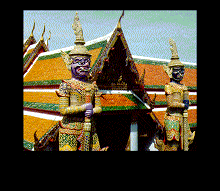
When you travel your experience is often affected by the knowledge of a place you carry with you. Of course knowing the language of the area would probably make traveling to any foreign destination the most rewarding because you can then seek out people to learn things about the places you visit, but this unfortunately is not always feasible. On our first visit to Thailand, we were entranced by the wats of Chiang Mai. I had taken a university course about Thailand, but what I learned was so far removed from such an introductory visit that it didn't seem to aid our experience very much. On this second visit to Thailand we did learn a little bit more about the country and one of the more useful things we learned was that Thailand was also a recipient of Hinduism which still lingers on if mostly superficially yet alongside the dominant practice of Buddhism in this host country. Hinduism, particularly in the image of the state symbol of a garuda, the Ramakien (the Thai version of the Hindu epic of the Ramayana written by the first king of the Chakri dynasty, Rama I), and images at wats, can be seen throughout Thailand. In Bangkok, it was also common to see statues throughout much of the wats of Chinese gods and zodiacal animals. We saw a fertility shrine that had at its center a spirit house-we had mistakenly identified spirit houses in our first visit to Thailand as alters, but they are more symbols of pre-Buddhist nativistic beliefs than anything. There is even a temple in Bangkok which symbolizes the center of Thailand. The center of this complex is a chedi, Buddhist, and the concept of the center of power is Hindu. This fluidity of the practice of Buddhism in Thailand, as religious practice in general throughout East Asia, is an interesting contrast with the apparent rigidity of religious practice in the West where wars have been fought over variants of the same religion.

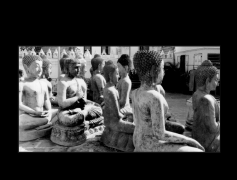
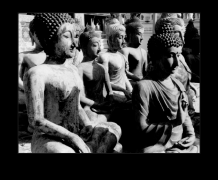

Outdoors on a mountain in Lantau Island, Hong Kong, we saw the awesome 26-meter high bronze seated Buddha (the world's largest). At the Lama Temple in Beijing, we saw the 18-meter high sandalwood standing Maitreya Buddha which was certainly amazing in its own right. In Kyoto we saw the 24-meter high ferro-concrete seated Bodhisattva Avalokitesvara (Kannon) which was a beautiful sight at a distance, the tan colored statue standing out against the greenery of the mountain location; in Nara we viewed the 16-meter high bronze Daibatsu Buddha; and in Kamakura we saw the 13th century, 11.4-meter tall bronze Daibutsu Buddha that had a more colorful past and was more beautiful than its cousin in Nara. Next to these, the reclining Buddha at Wat Pho in Bangkok was probably the most impressive large Buddha image we have seen. This one is so spectacular due to its relatively unique position, with the head being supported by an upraised hand; gold leaf in square inch strips covers a plaster body underneath; and the bottom of the immense feet are black and covered with religious scenes in mother-of-pearl inlay. It probably helps that it is housed in a relatively small building and yet there was still ample room for us to walk around this image so we could appreciate the different views offered of it.

The temple and a portion of the grounds at Wat Ratchabophit (also spelled Rajabophit) were closed for the holiday when we visited it, but it was jus as well. Thai wats typically have a feel of tranquility and casualness even in their reverence. This is in part why I think that Buddhism is more suffused into everyday life of the Thai than the practice of religion we have seen elsewhere, except perhaps the of Catholicism in the Philippines. The feeling of tranquility that I so liked about Thai wats was especially strong at Wat Ratchabophit, and I felt more comfortable than I usually do when I visit religious sights. Usually I have to be on my guard that I don't offend somebody's beliefs with my own lack of understanding and sometimes oafish manners, but since there were almost no people at the wat, I could wonder with Karen and admire the Buddhist sculptures representing a wide range of styles in one yard. There were several, perhaps fifteen or more, large sitting Buddha sculptures representing a wide range of styles in one yard of the compound. These Buddha sculptures were all about five feet high while in the sitting position and were proportional to this in thickness. They looked as if they had been placed their haphazardly in anticipation of the completion of construction for their permanent home. Ironically, the arrangement could not have been better had it been conceived by some master artist for the effect that was reached of the statues in such close proximity to each other made clear the similarities and dissimilarities of the statues. The lack of crowds, needless to say, made the viewing (or inspection) of the statues even more intimate.
(Another wat, Wat Benchamabophit, had a more numerous array of Buddhist sculptures cast in bronze that were arranged - rather than placed haphazardly - complete with explanations in Thai and English explaining which era of Thai Buddhist art each represented and the significance of the poses of the Buddhas; unfortunately you cannot walk around these latter group because they are placed traditionally with their backs against a wall.)
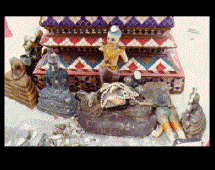
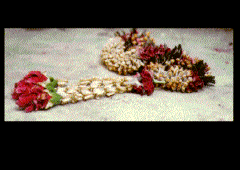

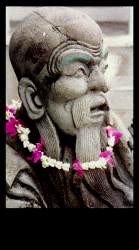
Wat Arun could equally be name the "Wat of Views." Its principal and ancillary chedis are picturesque in silhouette when viewed by boat on the Chao Phraya. The views of Bangkok, where at least two other wats fill in the skyline, across the Chao Phraya from the Wat Arun, in the Thonburi, are as impressive as most wats themselves. This wat, more than any other we had seen in Thailand, is a classic example of the admixture of styles of architecture in Thai Buddhism. The chedis are distinguished by colorful ceramic demons of the Thai epic, the Ramakien. Like several other wats in Bangkok, Wat Arun reveals the presence of Chinese immigrants in Thailand most obviously in the three-foot high unmistakably Chinese stone sculptures which are placed around the bots and in long rows in the temple grounds which most visitors seem to ignore. Another important symbol of the Thai approach to religion is the sight of foreigners (especially those from Buddhist countries) taking photos of interiors of religious buildings and statues of Buddha, these same foreigners would often consider it extremely irreverent to photograph such sacred images back home.
Wat Traimit is an unimpressive wat, but draws visitors who want their picture taken with its most famous resident, a three-meter, five and a half ton solid gold sitting Buddha. This Buddha was hidden within a larger, plaster Buddha figure until the less impressive exterior was shattered a few decades ago after being dropped by a crane while it was being moved. Had this particular image been housed somewhere in Europe or the United States there would undoutedly be thousands of dollars spent every year just to protect it. At Wat Traimit there wasn't so much as a guard looking on or a glass enclosure to protect it from the visitors.
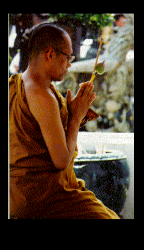


One night, as I walked to the Democracy Monument near the Grand Palace in Bangkok, I lived a sentence in a children's storybook. A policeman politely asked me to wait a few feet from an intersection and then added a word of explanation, "the King." A few moments later a motorcade led by police motorcycles and followed up in the rear by police cars drove past. There was a team of cream-colored Mercedes Benzes and a few vans in the King's entourage. I didn't see the King, but I did see a group of military officials who were certainly important because they were fat and highly decorated. I thought about taking my video camera out of its bag to record the scene, but worried that the quick movement to grab something as big as my video camera might cause some equally quick reaction by those protecting the King so I erred on the side of prudence.

There was a partial, nearly total, solar eclipse in Bangkok on October 24, 1995 (the total eclipse was visible further north). The Thai people used a broad spectrum of eye protection for viewing the event ranging from crude to sophisticated, high-tech improvisation: glass or plastic sheets with black paint sprayed on them, two pairs of sunglasses, cardboard made-for-the-event sun glasses, 35mm negatives, exposed x-ray film, a welding mask, and the exposed disk from a floppy diskette. To be fair, our approach was just as crude and perhaps dangerous to our vision had we not limited to a few brief seconds our viewing of the eclipse: the darkened window of a shopping mall.

Most Americans refer to the affliction we came down with one night as Montezuma's Revenge because they get it in Mexico. Our experience in Thailand gave diarrhea new meaning. It felt like somebody was wringing the water our of our body like you would a rag. The only difference between our "stools" and urine was that our "stools" were tinted yellowish-brown instead of light yellow (get the picture!?). Well since we got the pee-through-your-butthole syndrome in Bangkok we thought it appropriate to call it Chulalongkorn's Revenge. Of course we never did so publicly.

